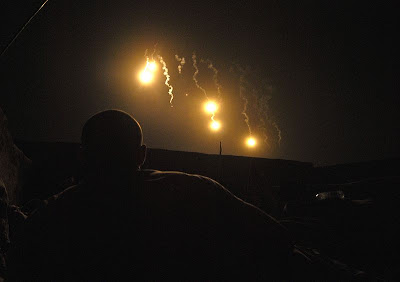
"Illumination rounds are fired during Operation Tora Arwa V in the Kandahar province during Operation Enduring Freedom. The illumination rounds were fired from M777 howitzers and are used to help illuminate a certain area the soldiers need to see."
"The art of fire is indeed the supreme art; for fire is at once the universal slave, the universal master." -- Henry B. Faber, Military Pyrotechnics, 1919.
FIAT LUX: LET THERE BE LIGHT.
Effective control of units on the battlefield depends largely on communication. Radio, telephone, voice, messenger, and arm-and-hand signals are communication means that at times are made ineffective by the tactical situation. Pyrotechnic signals are used in such situations to supplement or to take the place of normal communication means. -- FM 23-30 Grenades and Pyrotechnic Signals
The United States military spends billions of dollars every years on night vision and infrared equipment so that its soldiers and marines can "own the night." At the level where "the metal meets the meat," this means a huge consumption of a multitude of batteries. Few of us can afford the cost of the batteries, let alone the night vision devices. We can, however, make do as soldiers did prior to night vision, with military pyrotechnics -- either surplus or improvised.
Pyrotechnics can be used for signaling and illumination, or blinding an enemy, either with light or smoke. Let's talk about light first.
The earliest forms of military pyrotechnics were signal rockets used to communicate across the pre-radio battlefield. They can be, and are, still used for this purpose. At the squad leader's level, the most common means of pyrotechnic communication is the flare pistol.
Flare Pistols
One of my good friends has an example of a German flare pistol from World War One. It uses 26.5mm flares as does the example above (available from Sportsman's Guide).
Useful by day or night, different color flares, or combinations thereof, can be used to issue movement orders or designate targets for general fire. By night they are useful for illuminating small areas where the enemy might be moving through.
Star Clusters
In the U.S. military, flare pistols have been superseded by hand-held star-clusters and parachute flares, primarily because the pistol is was determined to be too limited to fill all needs of illumination.
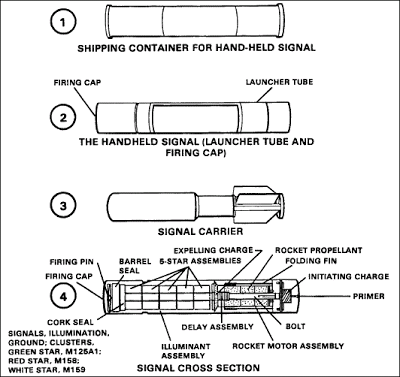
These are issued in a waterproof shipping tube (Vietnam-era was a metal tube with a sardine can opener, current issue is a plastic tube with resealable cap) inside of which is an expendable launcher,which consists of a launching tube and a firing cap (as illustrated above). These signals produce a cluster of five free-falling pyrotechnic stars. There are green (M125A1), red (M158) and white (M159) star clusters.
To operate, you hold the signal in your left hand with the red-knurled band down, holding your little finger in alignment with the red band. Remove the firing cap from the upper end of the signal. Point the ejection end of the signal away from the body and slowly push the firing cap onto the signal until the open end of the cap is aligned with the red band. It is now ready to fire. Grasp the center of the signal firmly with your left hand, holding your elbow tight against the body with the signal at the desired trajectory angle and the firing cap at the bottom. Turn your head down and away from the signal to avoid injuries to your face and eyes from particles ejected by the small rocket. Strike the bottom of the cap a sharp blow with the palm of your right hand, keeping the left arm rigid.
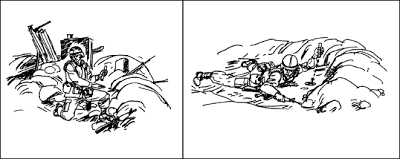
IMPORTANT: Before firing the signal, you MUST must make sure you have overhead clearance. Having a burning, blinding projectile bouncing back in your face from a chance encounter with a tree limb is not the best way to survive in combat.
This is how it works: When the firing cap is struck, the firing pin is forced into the base of the launcher tube at the primer. When the primer is struck, the flash from the primer ignites an initiating charge of black powder at the base of the signal. Gases from the burning initiating charge expel the signal from the launcher tube (rocket barrel) with a slight recoil. As the signal is expelled, four flexible steel fins unfold to stabilize the signal during flight. After the signal rises approximately 6 meters, the rocket motor, which was ignited by the propelling gases, begins to burn fully, forcing the signal to a height of 200 to 215 meters (650 to 700 feet). At that point, a delay element ignites an ejecting charge, which in turn forces the five-star illuminant cluster out of the nose of the signal body. Star clusters burn 6 to 10 seconds. Their rate of descent is 14 meters (45 feet) per second.
Star Parachutes.
Star parachutes are also used for signaling and illuminating. They are issued in an expendable launcher that consists of a launching tube and a firing cap. These signals produce a single parachute suspended illuminant star. The current types of star parachutes include the M126A1, red star parachute; the M127A1, white star parachute; and the M195, green star parachute. They are fired in the same manner as star clusters, and their function is the same.
The M126- and M127-series of star parachutes rise to a height of 200 to 215 meters. The M126 burns for 50 seconds and the M127 burns for 25 seconds. Their average rate of descent is 2.1 meters per second. The signal can be seen for 50 to 58 kilometers (30 to 35 miles) at night.
Obviously the parachute flares are optimal for illumination at night. A couple years ago there were some Czech hand-held flare projectors available at gun shows.
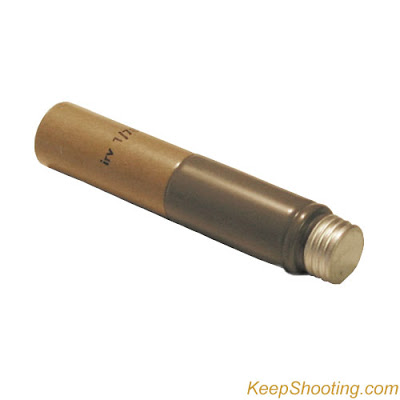
With these, you simply unscrew the cap at the bottom and a pull string deploys (like the fuse assembly on a German potato masher). Pay attention to the safety issues described above of overhead cover and pointing it away from your face, and simply pull the string smartly. I have used these at FTXs and they performed well.
They are not as weather-proof as the USGIs, but will conveniently fit inside an empty current-issue GI hand-kicker shipper tube:
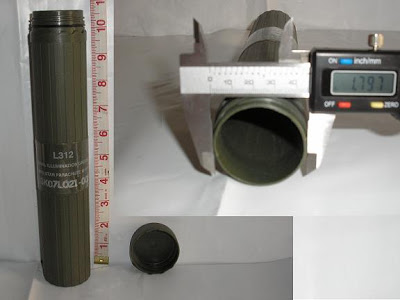
Trip Flares
Another use of illumination on the battlefield at night is the trip flare.
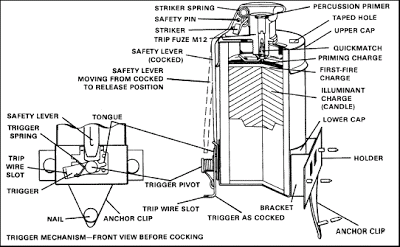
Surface trip flares outwardly resemble antipersonnel mines or hand grenades (see above). Their primary use is to warn of infiltrating troops by illuminating the field. They may also be used as signals or as booby traps. When activated, the flare produces up to 50,000 candlepower of illumination.
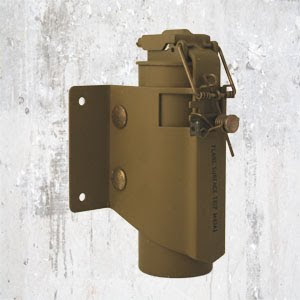 M49A1 Trip Flare.
M49A1 Trip Flare.The M49A1 Trip Flare is an early warning signaling device used to warn of infiltrating troops by illuminating the area surrounding the trip flare. The flare consists of an illuminant assembly, cover loading assembly and a mounting bracket assembly. The illuminant assembly is an aluminum case containing an ignition increment and three illuminant increments. The waterproof cover loading assembly contains a percussion primer, intermediate charge and a spring-loaded striker.
The flare is armed by attaching a trip-wire to either the trigger or pull-pin. Once the trip-wire has been hit, either the trigger tongue or pull pin will release the lever, which in turn permits the firing pin to strike the primer. The primer sets off the intermediate charge, and the intermediate charge ignites the first-fire composition on the ignition increment of the flare. The M49A1 trip flare will provide a light intensity exceeding 35,000 candle power for approximately one minute.
A trick an ex-82nd Airborne pathfinder taught me is to use the M49A1 as a means of blinding night vision devices (as well as enemy eyeballs) when breaking contact at night. He carried them (minus the bracket, with the lever taped down as a safety measure) in an ammo pouch and used them as throw-behinds as he ran. IMPORTANT TIP: When you pull the pin on an M49A1 (after first removing the tape), throw the the device behind you without delay, letting the spoon fly off as it leaves your hand. The reason? This is an instantaneously detonating grenade and you will be severely burned if you don't get rid of it in one swift, fluid motion.
FIAT FUMUS: LET THERE BE SMOKE.
The other important use of pyrotechnics on the battlefield is smoke, both for daylight signaling and for blinding the enemy so that you can maneuver across a danger space.
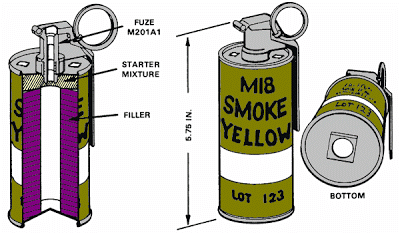
The US military uses the M18 Smoke Grenade as a ground-to-ground or ground-to-air signaling device, a target or landing zone marking device, or a screening device for unit movements. It has a sheet steel cylinder body with four emission holes at the top and one at the bottom to allow smoke release when the grenade is ignited. Weighing 19 ounces, it comes in white, red, green, yellow, and violet smoke varieties. It can be thrown about 35 meters by the average soldier. The grenade produces a cloud of colored smoke for 50 to 90 seconds. It is painted olive drab on the grenade body with the top indicating the smoke color.
Here is a video of how to use M18 smoke grenades to shield the removal of a casualty. (I rather wish they had replaced the cheesy music with instructional narrative.)
FIAT INFLATUS: LET THERE BE INSPIRATION.
Improvisation
You may say, "That's all very well, Vanderboegh, but we don't have a government arsenal to dip into." True, however, you often see these in onesey-twoseys at gun show and flea markets, so it is not a bad idea to be able to recognize them for what they are. Second, you never can tell what may be laying around on the road after the excrement hits the rotary oscillator. And third, there is no reason why these can't be improvised.
There are a number of interesting pyrotechnic manuals on the web. One of my favorites that I took the trouble to print out is Military and Civilian Pyrotechnics by Dr. Herbert Ellern.
Another useful book is Military Pyrotechnics: The Manufacture of Military Pyrotechnics by Henry B. Faber, U.S. Army Ordnance School, 1919.
A website that has links to these and other useful texts is Freepyinfom.com.
Among them are these two on improvised black powder production:
FIELD EXPEDIENT PREPARATION OF BLACK POWDERS.
And,
The Do-it-yourself Gunpowder Cookbook by Don McClean.
In any case, whether military-grade or improvised, pyrotechnics can provide an edge on the modern battlefield to those who know how to use them.
Mike
III
16 comments:
Making homemade smoke bombs is very easy. When I was young, dumb and mischievous we accidentally blanketed the nearby city highway in thick white smoke.
http://chemistry.about.com/od/demonstrationsexperiments/ss/smokebomb.htm
We just used a food tin with the top cut off and a regular wick, but I'm sure one can come up with all kinds of clever containers and fuse systems.
Very useful information,thanks. Been up all night reading excerpts from Absolved on the Western Rifle Shooters site,can´t wait for your book to come out.
I see by the time on your postings you've either been up all night also or got a very early start on your day hope your felling OK.
Dennis
III
Texas
One trick we used with the smoke grenades was to crush up a heat tab (trioxane) and place it in the body by peeling back the seal tape on the bottom of the grenade. I wasn't as effective as CS, though probably more dangerous. In any case, it caused the opfor to mask up. :)
Those hand-launched parachute flares pack a pretty good kick. I had to fire off three in a row on a night fire range. The third one got launched by pounding on the ground. The guy launching his three next to me made the mistake of launching his third one on the front of his thigh. Left a hell of a bruise!
Excellent post!
Thanks for filling in the blanks on these goodies.
Want to own the night.
Step 1. Buy Trijicon night sights for your defensive weapons.
Step 2. Buy quality night vision.
Step 3. Buy an IR laser for your rifle. Zero it to your weapon.
Step 1 is fairly cheap. Enough so that anybody can do it. Step 2 is downright expensive. Step 3 isn't that bad. Wish I could say you can gain a massive tactical advantage for some $29 gadget but that isn't real life.
Using flares and smoke grenades might be easier to understand than military radio jargon.
They are sold out. Available here at $64.95. http://www.keepshooting.com/militarysurplus/collectibles/flaregun.htm
Just be sure that your surplus starburst are, in fact, ground-launched starburst and not aerial flares (no propelling charge to speak of, instant ignition). A friend of mine set fire to his neighbors tree with an aerial flare.
Very handy info here, i have a feeling i'm gonna get in trouble with it though.
Eric
III
At the level where "the metal meets the meat," this means a huge consumption of a multitude of batteries. Few of us can afford the cost of the batteries, let alone the night vision devices.
Wonder if the use of wire coil capacitors might reduce the need for batteries? Operates by movement of a person. Could be used to recharge batteries.
you gotta like the way to create a position to where everybody is equal with you providing an angle to opposition. trip flares are cool to suprise more than common areial pho illum.
excellent article info!
Night vision doesn't use as many batteries as you may suspect. The 3d+ Gen PVS-14s use one AA battery. One pack of AA batteries from Costco would probably be enough. Better yet, get several rechargeable AA batteries and a recharger and batteries are no longer an issue. If you can afford the night vision gear, you can afford to stock a bunch of single use AA batteries and a set of rechargeable ones. Plus, it's a good idea to stock a bunch of AA batteries anyways...
Good stuff, Dutchman. For those who have or can get them, the US military flares (whether starburst or parachute) are hard as hell to launch by hand. We always smacked them on the ground. If you can't get your hands on smoke grenades, for concealment purposes never underestimate good ol' pine straw....can't get any cheaper, puts out a load of white smoke, plus when you light it up all spread out it creates multiple thermal signatures to spam IR.
Good idea with the trip flares, never thought of using 'em that way but it'd damn sure work!
Take care of them feets!
BoarHawg
Centerfire Systems has Czech surplus flare launchers.
$300, but they are brand new, and the only rifle flare launcher I've seen. The Czechs used them for riot control, too, so somewhere there should be foam baton or rubber pellet ammo. Might be possible to reload some in fired signal flare cases, dunno.
For $300 you could also get a Spike's Tactical 37mm m203 clone, which can be bored out to 40mm to use all the fun 40mm toys for <$100 at any machine shop or gunsmith. After paying the $200 fed tax of course.
Hi Mike,
Thx for the smokes!!
Used M18's bunches on Skydives. Ya' need a good boot bracket with a good quick release. Residu everywhere!! BEWARE!! M18 WHITE smoke has lots of white phosphoros and burns really "HOT!!" The can will catch on fire and melt!! Saw our CSO (Club Safety Officer) take one from an unsuspecting jumper, pull the pin and pitched it out on the flight line (no planes!) it "Burned!!"
As an old Squid Parachute Rigger, there's also the Navy Day/Night Org/Red signal flare. I think the designation is Mk 13 Mod O. These can be hand held! The smoke end gives about 20 sec of bright org/red smoke and the flare end is about 20 sec org/red flare. Little raised "Tits" are under the rim of the night end to ID in the dark.
III%,
skybill-out
I suspect that a flare pistol round or star cluster in the groin would upset a Bad Guy's OODA loop somewhat...
And hey, "singe" is the captcha!
Post a Comment